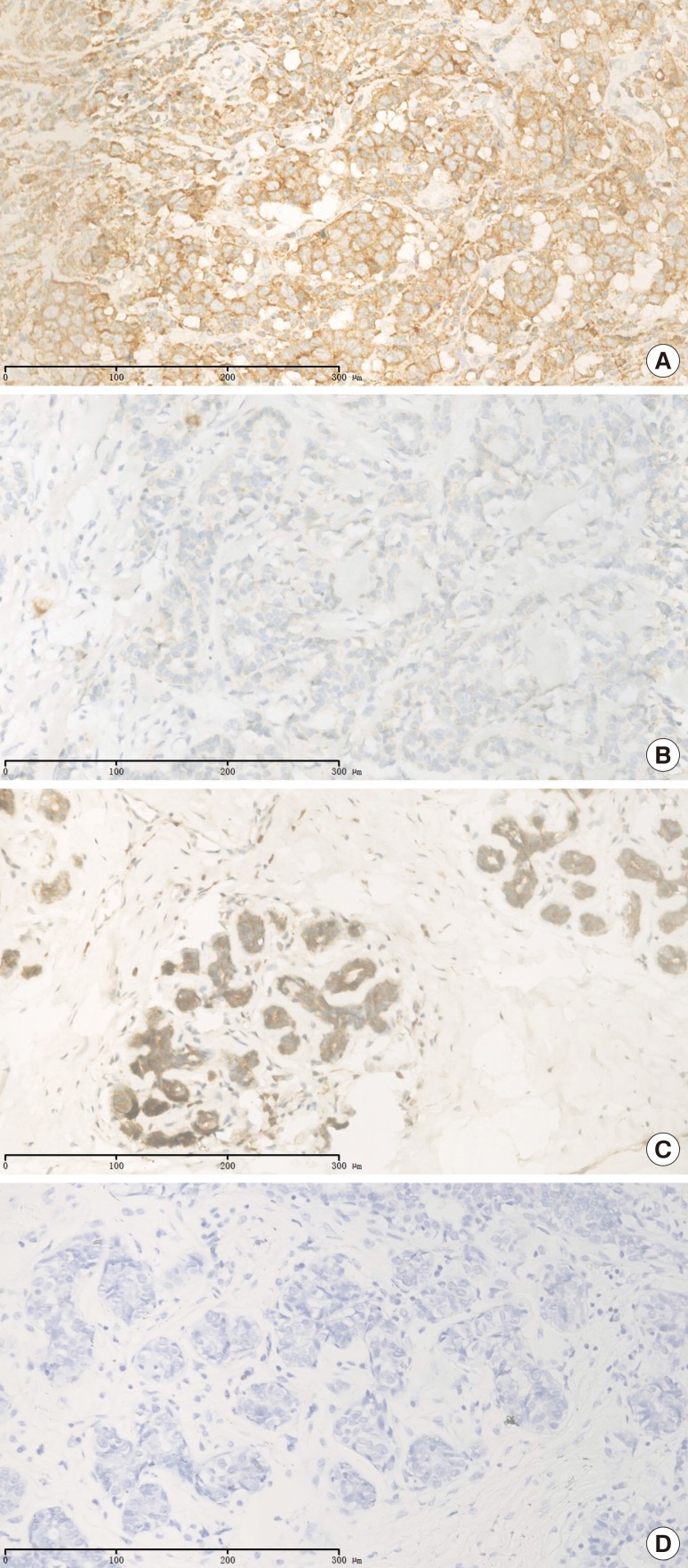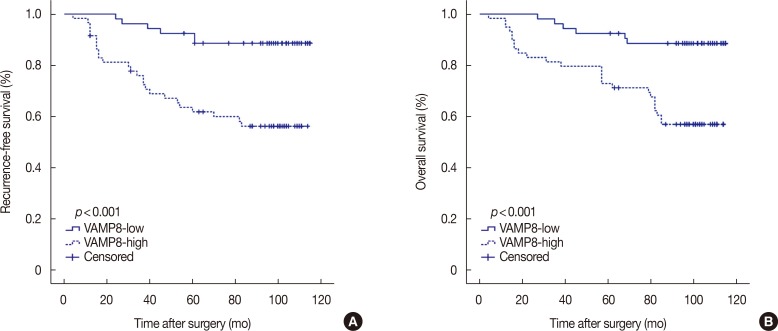J Breast Cancer.
2018 Dec;21(4):399-405. 10.4048/jbc.2018.21.e57.
Significance of Vesicle-Associated Membrane Protein 8 Expression in Predicting Survival in Breast Cancer
- Affiliations
-
- 1Division of Breast Surgery, Department of Surgical Oncology, Research Unit of General Surgery, The First Affiliated Hospital of China Medical University, Shenyang, China. jinfeng@cmu.edu.cn
- 2Department of General Surgery, Zhejiang Hospital, Hangzhou, China.
- KMID: 2429818
- DOI: http://doi.org/10.4048/jbc.2018.21.e57
Abstract
- PURPOSE
Vesicle-associated membrane protein 8 (VAMP8) is a soluble N-ethylmaleimide-sensitive factor receptor protein that participates in autophagy by directly regulating autophagosome membrane fusion and has been reported to be involved in tumor progression. Nevertheless, the expression and prognostic value of VAMP8 in breast cancer (BC) remain unknown. This study aimed to evaluate the clinical significance and biological function of VAMP8 in BC.
METHODS
A total of 112 BC samples and 30 normal mammary gland samples were collected. The expression of VAMP8 was assessed in both BC tissues and normal mammary gland tissues via a two-step immunohistochemical detection method.
RESULTS
The expression of VAMP8 in BC tissues was significantly higher than that in normal breast tissues. Furthermore, increased VAMP8 expression was significantly correlated with tumor size (p=0.007), lymph node metastasis (p=0.024) and recurrence (p=0.001). Patients with high VAMP8 expression had significantly lower cumulative recurrence-free survival and overall survival (p < 0.001 for both) than patients with low VAMP8 expression. In multivariate logistic regression and Cox regression analyses, lymph node metastasis and VAMP8 expression were independent prognostic factors for BC.
CONCLUSION
VAMP8 is significantly upregulated in human BC tissues and can thus be a practical and potentially effective surrogate marker for survival in BC patients.
Keyword
MeSH Terms
Figure
Reference
-
1. Chen W, Zheng R, Baade PD, Zhang S, Zeng H, Bray F, et al. Cancer statistics in China, 2015. CA Cancer J Clin. 2016; 66:115–132. PMID: 26808342.
Article2. Dowsett M, Dunbier AK. Emerging biomarkers and new understanding of traditional markers in personalized therapy for breast cancer. Clin Cancer Res. 2008; 14:8019–8026. PMID: 19088018.
Article3. Peng RW, Abellan E, Fussenegger M. Differential effect of exocytic SNAREs on the production of recombinant proteins in mammalian cells. Biotechnol Bioeng. 2011; 108:611–620. PMID: 21246508.
Article4. Lau SK, Boutros PC, Pintilie M, Blackhall FH, Zhu CQ, Strumpf D, et al. Three-gene prognostic classifier for early-stage non small-cell lung cancer. J Clin Oncol. 2007; 25:5562–5569. PMID: 18065728.5. Hasan N, Hu C. Vesicle-associated membrane protein 2 mediates trafficking of alpha5beta1 integrin to the plasma membrane. Exp Cell Res. 2010; 316:12–23. PMID: 19822142.6. Zarzynska JM. The importance of autophagy regulation in breast cancer development and treatment. Biomed Res Int. 2014; 2014:710345. PMID: 25317422.
Article7. Chen Y, Meng D, Wang H, Sun R, Wang D, Wang S, et al. VAMP8 facilitates cellular proliferation and temozolomide resistance in human glioma cells. Neuro Oncol. 2015; 17:407–418. PMID: 25209430.
Article8. Gomes LR, Terra LF, Wailemann RA, Labriola L, Sogayar MC. TGF-β1 modulates the homeostasis between MMPs and MMP inhibitors through p38 MAPK and ERK1/2 in highly invasive breast cancer cells. BMC Cancer. 2012; 12:26. PMID: 22260435.
Article9. Fang Y, Chen Y, Yu L, Zheng C, Qi Y, Li Z, et al. Inhibition of breast cancer metastases by a novel inhibitor of TGFβ receptor 1. J Natl Cancer Inst. 2013; 105:47–58. PMID: 23178439.
Article10. Langlands FE, Horgan K, Dodwell DD, Smith L. Breast cancer subtypes: response to radiotherapy and potential radiosensitisation. Br J Radiol. 2013; 86:20120601. PMID: 23392193.
Article11. Siegel R, Naishadham D, Jemal A. Cancer statistics, 2012. CA Cancer J Clin. 2012; 62:10–29. PMID: 22237781.
Article12. Fung C, Lock R, Gao S, Salas E, Debnath J. Induction of autophagy during extracellular matrix detachment promotes cell survival. Mol Biol Cell. 2008; 19:797–806. PMID: 18094039.
Article13. Martinet W, Agostinis P, Vanhoecke B, Dewaele M, De Meyer GR. Autophagy in disease: a double-edged sword with therapeutic potential. Clin Sci (Lond). 2009; 116:697–712. PMID: 19323652.
Article14. Santagata S, Hu R, Lin NU, Mendillo ML, Collins LC, Hankinson SE, et al. High levels of nuclear heat-shock factor 1 (HSF1) are associated with poor prognosis in breast cancer. Proc Natl Acad Sci U S A. 2011; 108:18378–18383. PMID: 22042860.
Article15. Desai S, Liu Z, Yao J, Patel N, Chen J, Wu Y, et al. Heat shock factor 1 (HSF1) controls chemoresistance and autophagy through transcriptional regulation of autophagy-related protein 7 (ATG7). J Biol Chem. 2013; 288:9165–9176. PMID: 23386620.
Article16. Lin CJ, Lee CC, Shih YL, Lin TY, Wang SH, Lin YF, et al. Resveratrol enhances the therapeutic effect of temozolomide against malignant glioma in vitro and in vivo by inhibiting autophagy. Free Radic Biol Med. 2012; 52:377–391. PMID: 22094224.
Article17. Cheng P, Ni Z, Dai X, Wang B, Ding W, Rae Smith A, et al. The novel BH-3 mimetic apogossypolone induces Beclin-1- and ROS-mediated autophagy in human hepatocellular carcinoma [corrected] cells. Cell Death Dis. 2013; 4:e489. PMID: 23392177.18. Kim YN, Koo KH, Sung JY, Yun UJ, Kim H. Anoikis resistance: an essential prerequisite for tumor metastasis. Int J Cell Biol. 2012; 2012:306879. PMID: 22505926.
Article19. Degenhardt K, Mathew R, Beaudoin B, Bray K, Anderson D, Chen G, et al. Autophagy promotes tumor cell survival and restricts necrosis, inflammation, and tumorigenesis. Cancer Cell. 2006; 10:51–64. PMID: 16843265.
Article20. Prietsch RF, Monte LG, da Silva FA, Beira FT, Del Pino FA, Campos VF, et al. Genistein induces apoptosis and autophagy in human breast MCF-7 cells by modulating the expression of proapoptotic factors and oxidative stress enzymes. Mol Cell Biochem. 2014; 390:235–242. PMID: 24573886.
Article21. Ganley IG, Wong PM, Gammoh N, Jiang X. Distinct autophagosomal-lysosomal fusion mechanism revealed by thapsigargin-induced autophagy arrest. Mol Cell. 2011; 42:731–743. PMID: 21700220.
Article22. Moreau K, Renna M, Rubinsztein DC. Connections between SNAREs and autophagy. Trends Biochem Sci. 2013; 38:57–63. PMID: 23306003.
Article23. Zhu D, Zhang Y, Lam PP, Dolai S, Liu Y, Cai EP, et al. Dual role of VAMP8 in regulating insulin exocytosis and islet β cell growth. Cell Metab. 2012; 16:238–249. PMID: 22841572.
Article24. Zhao P, Yang L, Lopez JA, Fan J, Burchfield JG, Bai L, et al. Variations in the requirement for v-SNAREs in GLUT4 trafficking in adipocytes. J Cell Sci. 2009; 122(Pt 19):3472–3480. PMID: 19759285.
Article25. Behrendorff N, Dolai S, Hong W, Gaisano HY, Thorn P. Vesicle-associated membrane protein 8 (VAMP8) is a SNARE (soluble N-ethylmaleimidesensitive factor attachment protein receptor) selectively required for sequential granule-to-granule fusion. J Biol Chem. 2011; 286:29627–29634. PMID: 21733851.
Article26. von Thun A, Birtwistle M, Kalna G, Grindlay J, Strachan D, Kolch W, et al. ERK2 drives tumour cell migration in three-dimensional microenvironments by suppressing expression of Rab17 and liprin-β2. J Cell Sci. 2012; 125(Pt 6):1465–1477. PMID: 22328529.
- Full Text Links
- Actions
-
Cited
- CITED
-
- Close
- Share
- Similar articles
-
- Expression Status and Prognostic Value of bcl-2 Protein in Breast Cancer
- Expression and Role of Epithelial Membrane Proteins in Tumorigenesis of Hormone Receptor-Positive Breast Cancer
- Nm23 Protein as a Prognostic Factor in Lymph Node Negative Breast Cancers
- Clinicopathological Significance of SMAD4 Expression in Breast Cancer
- Change of Mad1 Expression in Human Breast Cancer and Normal Breast Tissues



